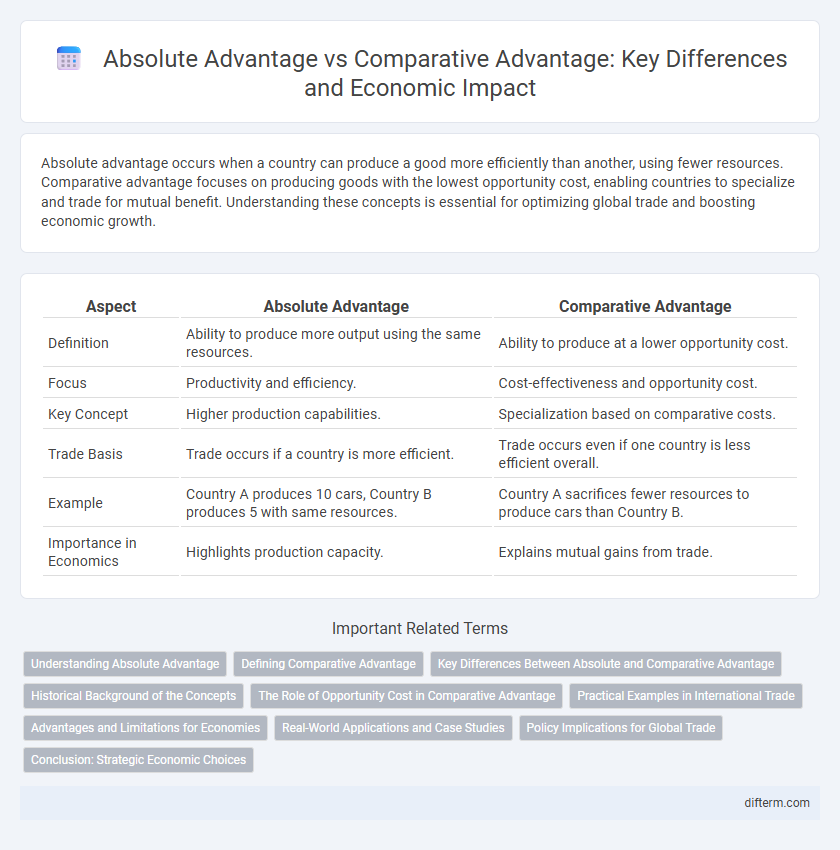Absolute advantage occurs when a country can produce a good more efficiently than another, using fewer resources. Comparative advantage focuses on producing goods with the lowest opportunity cost, enabling countries to specialize and trade for mutual benefit. Understanding these concepts is essential for optimizing global trade and boosting economic growth.
Table of Comparison
| Aspect | Absolute Advantage | Comparative Advantage |
|---|---|---|
| Definition | Ability to produce more output using the same resources. | Ability to produce at a lower opportunity cost. |
| Focus | Productivity and efficiency. | Cost-effectiveness and opportunity cost. |
| Key Concept | Higher production capabilities. | Specialization based on comparative costs. |
| Trade Basis | Trade occurs if a country is more efficient. | Trade occurs even if one country is less efficient overall. |
| Example | Country A produces 10 cars, Country B produces 5 with same resources. | Country A sacrifices fewer resources to produce cars than Country B. |
| Importance in Economics | Highlights production capacity. | Explains mutual gains from trade. |
Understanding Absolute Advantage
Absolute advantage refers to a country's ability to produce a good or service more efficiently than another country using the same resources. This concept highlights productivity differences and emphasizes maximizing output by focusing on industries where a nation outperforms competitors. Understanding absolute advantage helps identify sectors with superior production capabilities, driving economic growth and trade benefits.
Defining Comparative Advantage
Comparative advantage refers to an economy's ability to produce goods or services at a lower opportunity cost than other economies, enabling more efficient resource allocation and trade specialization. It drives international trade by allowing countries to benefit from producing products where they have relative efficiency, even if one country holds an absolute advantage in all goods. Understanding comparative advantage is essential for optimizing production, maximizing global output, and increasing overall economic welfare.
Key Differences Between Absolute and Comparative Advantage
Absolute advantage refers to a country's ability to produce a good more efficiently than another country using fewer resources, while comparative advantage focuses on the lower opportunity cost of producing a good. The key difference lies in resource efficiency for absolute advantage versus opportunity cost minimization for comparative advantage. Understanding these distinctions helps countries specialize in production to maximize overall economic welfare through trade.
Historical Background of the Concepts
Absolute advantage, first articulated by Adam Smith in the 18th century, emphasizes the ability of a country to produce goods more efficiently than others. Comparative advantage, introduced by David Ricardo in the early 19th century, focuses on the relative opportunity cost of production, allowing countries to benefit from trade even if one holds an absolute advantage in all goods. These foundational economic concepts have shaped modern trade theory by explaining how nations specialize and engage in mutually beneficial exchange.
The Role of Opportunity Cost in Comparative Advantage
Comparative advantage hinges on the concept of opportunity cost, where a country or producer specializes in goods with the lowest opportunity cost compared to others. This specialization allows for more efficient resource allocation and increased overall production, even if one party has an absolute advantage in producing all goods. Understanding opportunity cost is crucial for maximizing trade benefits and gaining economic efficiency in global markets.
Practical Examples in International Trade
Absolute advantage occurs when a country can produce a good more efficiently than another, such as Saudi Arabia's dominance in oil production due to vast reserves and low extraction costs. Comparative advantage focuses on relative opportunity costs, exemplified by Bangladesh specializing in textile manufacturing despite low productivity, because it sacrifices less compared to other goods. These principles drive international trade by encouraging countries to export products where they hold efficiency or cost benefits, maximizing global resource allocation and economic growth.
Advantages and Limitations for Economies
Absolute advantage enables economies to produce goods more efficiently using fewer resources, leading to higher productivity and potential cost savings. Comparative advantage allows economies to specialize in producing goods with the lowest opportunity cost, maximizing overall trade benefits and resource allocation. Limitations include vulnerability to market changes, dependence on trade partners, and potential neglect of domestic industries or emerging sectors.
Real-World Applications and Case Studies
Absolute advantage allows countries like Saudi Arabia to efficiently produce oil due to abundant reserves, while comparative advantage drives nations such as Bangladesh to specialize in textiles, leveraging lower labor costs despite lacking overall efficiency. Real-world case studies reveal that trade patterns often reflect comparative advantage, as exemplified by the U.S. focusing on high-tech goods and China on electronics assembly, maximizing global resource allocation. Understanding these concepts explains the specialization and mutual benefits seen in international trade agreements and economic policies worldwide.
Policy Implications for Global Trade
Absolute advantage refers to a country's ability to produce goods more efficiently than others, while comparative advantage focuses on producing goods at a lower opportunity cost. Policymakers should prioritize trade agreements that leverage comparative advantage to enhance overall economic efficiency and promote specialization. Emphasizing comparative advantage encourages global cooperation, optimizes resource allocation, and drives sustainable economic growth in international markets.
Conclusion: Strategic Economic Choices
Strategic economic choices hinge on leveraging comparative advantage rather than absolute advantage to maximize overall efficiency and gains from trade. While absolute advantage highlights superior productivity in producing certain goods, focusing on comparative advantage allows nations to specialize based on relative opportunity costs, driving higher global welfare. Policymakers should prioritize trade and resource allocation strategies that reflect comparative advantages to optimize economic outcomes and sustain competitive growth.
Absolute advantage vs Comparative advantage Infographic

 difterm.com
difterm.com